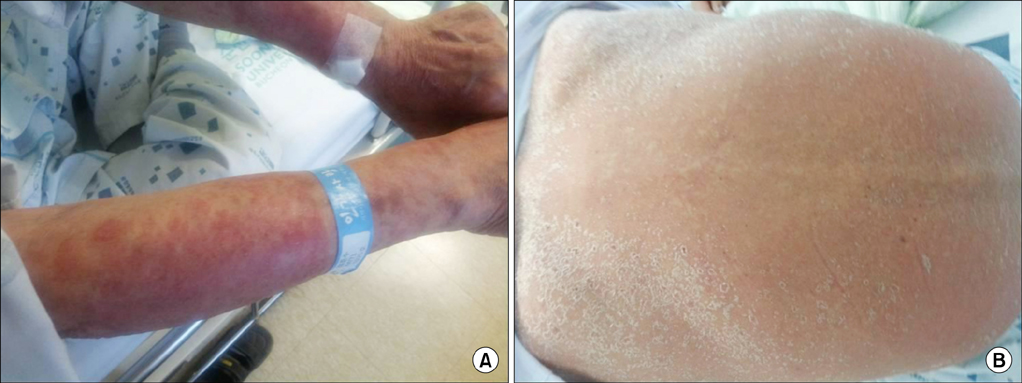Tuberc Respir Dis.
2015 Jan;78(1):27-30. 10.4046/trd.2015.78.1.27.
A Case of the Drug Reaction with Eosinophilia and Systemic Symptom (DRESS) Following Isoniazid Treatment
- Affiliations
-
- 1Department of Internal Medicine, Soonchunhyang University Bucheon Hospital, Bucheon, Korea. jas877@schmc.ac.kr
- KMID: 2114646
- DOI: http://doi.org/10.4046/trd.2015.78.1.27
Abstract
- The drug reaction with eosinophilia and systemic symptom (DRESS) syndrome is a severe adverse drug-induced reaction which includes a severe skin eruption, fever, hematologic abnormalities (eosinophilia or atypical lymphocytes) and internal organ involvement. The most frequently reported drug was anticonvulsants. The diagnosis of DRESS syndrome is challenging because the pattern of cutaneous eruption and the types of organs involved are various. The treatments for DRESS syndrome are culprit drug withdrawal and corticosteroids. Here we report a 71-year-old man with skin eruption with eosinophilia and hepatic and renal involvement that appeared 4 weeks after he had taken anti-tuberculosis drugs (isoniazid, ethambutol, rifampicin, and pyrazinamide), and resolved after stopping anti-tuberculosis drugs and the administration of systemic corticosteroids. DRESS recurred after re-challenging isoniazid, we identified isoniazid was causative drug.
Keyword
MeSH Terms
Figure
Cited by 2 articles
-
Prevalence and Clinical Features of Drug Reactions With Eosinophilia and Systemic Symptoms Syndrome Caused by Antituberculosis Drugs: A Retrospective Cohort Study
Ho Yeon Jung, Sunmin Park, Beomsu Shin, Ji-Ho Lee, Seok Jeong Lee, Myoung Kyu Lee, Won-Yeon Lee, Suk Joong Yong, Sang-Ha Kim
Allergy Asthma Immunol Res. 2019;11(1):90-103. doi: 10.4168/aair.2019.11.1.90.DRESS (drug reaction with eosinophilia and systemic symptom) syndrome caused by both first-line and second-line antitubercular medications: A case report with a brief literature review
Young-Hoon Hwang, Dong Yeon Jang, Sung Yoon Kang, Kyung-Hee Sohn, Dong Yoon Kang, Chang Hoon Lee, Hye-Ryun Kang
Allergy Asthma Respir Dis. 2017;5(2):111-116. doi: 10.4168/aard.2017.5.2.111.
Reference
-
1. Bocquet H, Bagot M, Roujeau JC. Drug-induced pseudolymphoma and drug hypersensitivity syndrome (Drug Rash with Eosinophilia and Systemic Symptoms: DRESS). Semin Cutan Med Surg. 1996; 15:250–257.2. Cacoub P, Musette P, Descamps V, Meyer O, Speirs C, Finzi L, et al. The DRESS syndrome: a literature review. Am J Med. 2011; 124:588–597.3. Shear NH, Spielberg SP. Anticonvulsant hypersensitivity syndrome: in vitro assessment of risk. J Clin Invest. 1988; 82:1826–1832.4. Descamps V, Valance A, Edlinger C, Fillet AM, Grossin M, Lebrun-Vignes B, et al. Association of human herpesvirus 6 infection with drug reaction with eosinophilia and systemic symptoms. Arch Dermatol. 2001; 137:301–304.5. Ichiche M, Kiesch N, De Bels D. DRESS syndrome associated with HHV-6 reactivation. Eur J Intern Med. 2003; 14:498–500.6. Picard D, Janela B, Descamps V, D'Incan M, Courville P, Jacquot S, et al. Drug reaction with eosinophilia and systemic symptoms (DRESS): a multiorgan antiviral T cell response. Sci Transl Med. 2010; 2:46ra62.7. Tas S, Simonart T. Management of drug rash with eosinophilia and systemic symptoms (DRESS syndrome): an update. Dermatology. 2003; 206:353–356.8. Tas S, Simonart T. Drug rash with eosinophilia and systemic symptoms (DRESS syndrome). Acta Clin Belg. 1999; 54:197–200.9. Roujeau JC. Treatment of severe drug eruptions. J Dermatol. 1999; 26:718–722.10. Callot V, Roujeau JC, Bagot M, Wechsler J, Chosidow O, Souteyrand P, et al. Drug-induced pseudolymphoma and hypersensitivity syndrome. Two different clinical entities. Arch Dermatol. 1996; 132:1315–1321.11. Roujeau JC, Stern RS. Severe adverse cutaneous reactions to drugs. N Engl J Med. 1994; 331:1272–1285.12. Palmero D, Castagnino J, Musella RM, Mosca C, Gonzalez Montaner P, de Casado GC. Difficult clinical management of anti-tuberculosis DRESS syndrome. Int J Tuberc Lung Dis. 2013; 17:76–78.13. Kim JH, Jang SH, Kim DH, Park S, Kim DG, Jung KS. A case of DRESS syndrome induced by the antituberculosis drugs, prothionamide, and para-aminosalycilic acid. Ann Allergy Asthma Immunol. 2013; 110:118–119.14. Rodríguez R, Jover V, Orozco I, Domenech J. DRESS syndrome in a 19-year-old patient following the administration of first-line antituberculosis drugs. J Investig Allergol Clin Immunol. 2012; 22:380–381.
- Full Text Links
- Actions
-
Cited
- CITED
-
- Close
- Share
- Similar articles
-
- Drug Reaction with Eosinophilia and Systemic Symptom Syndrome Due to Everolimus: A Case Report
- Concomitant Drug Reaction with Eosinophilia and Systemic Symptom Syndrome from Ethambutol and Autoimmune Hepatitis from Isoniazid
- DRESS (drug reaction with eosinophilia and systemic symptom) syndrome caused by both first-line and second-line antitubercular medications: A case report with a brief literature review
- Drug reaction with eosinophilia and systemic symptom induced in a 9-year-old boy
- Diagnosis and Management of DRESS (Drug Reaction with Eosinophilia and Systemic Symptoms) Syndrome




